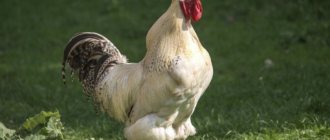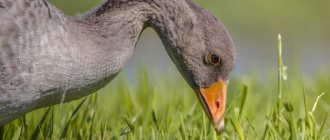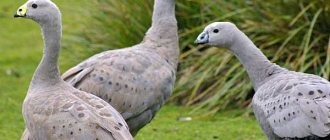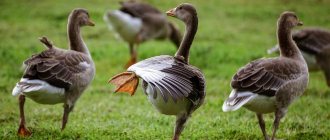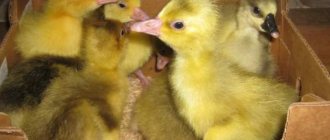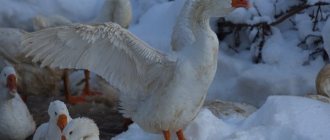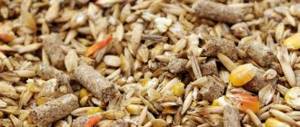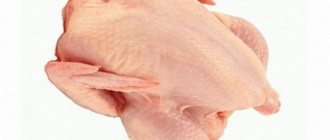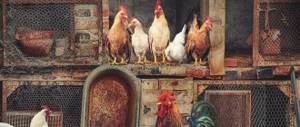At what age should geese be slaughtered for meat?
When raising birds for meat, they are chopped from the age of 4 months. The specific period is determined by the breed of bird and its diet. Simple village gray or white geese that ate grass and a minimal amount of grain reach the required weight only in six months. Broiler meat breeds are considered to be very early maturing and grow quickly. If birds eat compound feed, they can be sent for slaughter as early as 4 months.
If geese are raised for down, the timing should be adjusted to take into account the time of molting. Goose cannot be slaughtered before 4 months of age. At this point, the bird's first molt is not yet complete. By about 4 months, the fluff is completely replaced by adult feathers. At the same time, the bird’s stumps—feathers that grow on its body—disappear.
Expert opinion
Zarechny Maxim Valerievich
Agronomist with 12 years of experience. Our best country expert.
Ask a Question
According to reviews from culinary experts, the most delicious and juicy meat is produced by geese that are 7-8 months old. By this point, the meat is fully matured, and the liver reaches large sizes.
An early ripening individual of the meat breed weighs, on average, 4-5 kilograms by the age of 4 months. After removing the entrails, paws, feathers and head, the weight of the carcass usually does not exceed 2.5-3 kilograms.
How long do geese grow before slaughter?
How long does it take a goose to grow before slaughter? First of all, the timing of geese slaughter depends on the characteristics of the breed being raised, as well as on their diet.
- If birds were fed only natural, nutritious foods from a very early age and they gained weight well, then geese can be slaughtered at the age of 7 months.
- Birds that ate only compound feed will gain about 3-4 kg in 2-3 months. Therefore, they can already be slaughtered at this age.
- Birds raised at home on mixed feeding are ready for slaughter at the age of 5 months.
First, approximately 5 of the most productive individuals are selected from the entire livestock for further breeding. The rest of the young animals can be slaughtered.
Birds should be slaughtered in the fall, starting in October or November. The exact time of slaughter depends on the degree of fattening of the geese.
If the birds did not have time to gain weight and grow before autumn, then it would be better to leave them for another year. In the winter they are in breeding season, so they lose some weight.
It should be remembered that geese gain their greatest weight only at the age of two years.
Preparation for the process
When slaughtering geese at home, you should follow some rules. Their violation provokes a deterioration in the taste of meat and a decrease in shelf life. First of all, it is important to cleanse the bird’s intestines of feces. To do this, you should not feed the birds before slaughter for 8-12 hours. This period cannot be increased, as this will negatively affect the taste of the meat.
However, it is not recommended to limit birds to water. Before slaughter, birds should be given salted liquid to drink. This helps extend the storage time of the carcass. Usually, during periods of famine, it is recommended to separate geese that are intended for slaughter from the rest of the population. It is advisable to sit at night. In this situation, it is acceptable to slaughter the birds in the morning.
If sitting is carried out during the daytime, the place where the birds are located needs to be darkened.
Vladimir geese
The breed is distinguished by its calm character and height. These geese are large, they get a lot of meat. However, breeding Vladimir claybirds has not become popular. This is due to their gray-brown color, which makes the carcass unattractive and due to the low fertilization of eggs, which does not exceed 55%. Otherwise, the breed is worthy of attention.
When raising geese for meat at home, you can get up to 8 or more kilograms of excellent product from one bird. The breed's egg production is average, up to 40 eggs. They raise their offspring themselves. The goslings grow quickly and by two months weigh about 4 kilograms.
Slaughtering techniques
There are several options for slaughtering techniques, each of which has certain advantages and disadvantages.
See also
Description and characteristics of Ural gray and white geese, breeding Read
External method
To slaughter birds this way at home, you should prepare sharp scissors. They must have long blades. First, the bird should be tied and positioned upside down. To prevent the goose from flapping its wings, it is recommended to place it in a special cone with a hole for its head.
To slaughter a goose, do the following:
- open the beak and place the scissors in the mouth;
- cut the veins and pierce the palate so that the scissors reach the brain;
- release blood;
- After half an hour, start plucking the bird.
Advantages and disadvantages
high efficiency;
high speed of manipulation;
ease of manipulation if you have the skills.
the need for special tools;
the need for appropriate skills.
Internal method
To spear geese using this method, they need to be secured in the same way as with the external method. After this, cut the throat under the beak with a sharp knife. The incision should be deep enough to reach the vertebrae. To facilitate blood removal, the head should be separated immediately.
Advantages and disadvantages
high speed;
accuracy of manipulation;
accuracy.
the need to separate the head;
the need for certain skills and knowledge.
With an ax
The goose is often chopped with an axe. To slaughter a bird, it is recommended to do the following:
- quickly chop off the head with an ax;
- hang the carcass upside down to drain the blood;
- proceed to plucking.
Advantages and disadvantages
high speed;
simplicity of the procedure.
the need for a sharply sharpened tool;
need for skills.
Industrial slaughter method
On an industrial scale, it takes a long time to slaughter birds. To speed up this procedure, special conveyor lines are used. They help quickly slaughter, pluck and gut the carcass.
Advantages and disadvantages
high speed of the procedure;
process automation;
no need for human intervention.
the need for appropriate equipment;
need for skills to operate devices.
Rules for slaughtering and butchering a goose at home
The bird is slaughtered before molting, the exact time of which is determined as follows: it takes from 270 to 310 days to grow and mature a goose, depending on the breed. If birds on pasture begin to lose their feathers or they can be pulled out without persistence, and no blood appears, then molting has begun and it is time to slaughter them for meat. You can feel the body of the bird under the wings by running your hand along the body in the opposite direction of feather growth. The absence of stumps under the wing on the body indicates the time has come for slaughter. If stumps are found, then the goose must be left until the next molt, because when plucked, these bristles will torture anyone, and the goose carcass will take on an unmarketable appearance. Timely slaughter will help extend the shelf life of meat.
Basic rules for preparing poultry for slaughter
Before full maturity, a goose grows for 6-7 months, and an adult weighs on average 4-5 kg, and some breeds reach 8 kg. Age affects the quality of goose meat, so they are slaughtered at a young age. Before slaughtering geese, it is necessary to carry out a set of measures to facilitate this process:
- 1. Carry out a sitting period (keep the bird in a separate room without feeders and food for half a day until slaughter) so that the geese can empty their intestines of processed food. Sitting for more than 12 hours worsens the taste of meat.
- 2. Give it lightly salted water, which will subsequently have a beneficial effect on the shelf life of the finished meat.
- 3. It is better to do slaughter in the morning. If you cannot spend a period of sitting at night, it is recommended to darken the room.
Slaughtering technique
There are two methods of slaughtering poultry - internal and external.
Internal method
When performed correctly, a person can lay down in a few seconds. For this you will need a rope and sharp scissors or a knife. Procedure for internal slaughtering technique:
- 1. Having tied the paws, hang the goose head down.
- 2. Hook the rope onto some nail sticking out of the wall.
- 3. Unclench the bird’s beak, insert scissors into the oral cavity, and with a sharp and strong movement cut the veins - the jugular and pavement. This is not difficult to do, because they are close to each other.
- 4. Without removing the scissors, pierce the palate and direct the tip to the cerebellum of the bird. It is easy enough to damage it, but there is no need to carefully cut and remove it. After this, the bird is left to drain the blood. It should be removed from the hook only after bleeding, otherwise the meat will not retain its taste.
A person needs to know the anatomy of geese: where the veins, arteries, and cerebellum are located - in order to carry out correct and quick slaughter without effort.
External method
You will need a special cone, previously purchased at the store, and a large sharpened knife. Procedure:
- 1. Place the goose head down in the cone. It should hang from the bottom hole of the cone. If the device is made of polymer, then the head will easily fit into it. With a metal cone the procedure is more complicated.
- 2. It is necessary to apply a sharp, strong blow to the bird’s head with a stick to stun it, so that the bird does not suffer and does not pinch the person’s fingers.
- 3. Take the head of the stunned bird in your left hand, and make a deep cut in the area of the lobe with your right hand. With a strong movement, cut the artery and jugular vein of the goose.
- 4. Leave the bird's head in the cone until all the blood has drained out. Residual blood in meat reduces shelf life and affects the taste of the product.
Without a special cone, killing a bird is quite difficult. If there is no cone, the internal method will be preferable.
How to pluck a bird
After draining the blood from the carcass, you can proceed to the plucking process. To avoid blood getting on the down and feathers, it is recommended to tighten the tip of the neck tightly with a rope. Birds can be plucked dry or wet. The first option is used to collect fluff and feathers. Immediately after plucking, they can be sorted and processed.
See also
How and how much fish oil should be given to goslingsRead
When using the wet method, the carcass must be scalded with boiling water. This option for the procedure is considered simpler and faster.
When to cut geese so that there are no stumps?
Each bird's feathers are easily removed before molting.
Typically this time falls between 150 – 180 days. However, much depends on the breed and method of keeping the bird. Early maturing breeds of geese will be suitable for slaughter much earlier. According to reviews from breeders, the time when geese can be slaughtered so that there are no stumps is approximately 130 days. Most breeders actively send ducks to slaughter in the fall. Poultry farmers keep only about 5 – 7 individuals as the parent flock. In the new season, this amount will be enough for them to lay eggs. Approximately in the second half of October - November, poultry farmers begin to slaughter geese for meat for themselves and for sale.
Geese are sent for slaughter when the weight of the bird carcass is about 3.5 - 4 kg. Birds gain this weight in approximately 4 to 5 months. Later they become too fatty and lose their dietary value. Many housewives at the market reluctantly buy too fatty poultry, preferring leaner meat.
When geese are fed grain, vegetables and other natural food, they grow longer. However, the meat of such a bird will be more tasty and healthy. A completely different matter is geese raised on factory feed. This bird grows faster. It can be sent for slaughter at the age of 70–80 days.
How to butcher a carcass
Cutting must be carried out with extreme caution, as this can lead to a deterioration in the taste of the meat and the appearance of the carcass. To carry out the procedure, do the following:
- Before starting the manipulation, make sure the mascara is clean. It cannot have feathers or down. It is permissible to remove dirt manually or with tweezers.
- Remove the bird's head. To do this, make an incision in the skin in the area of the second vertebra.
- Cut off the wings in the area of the bend of the elbow and the paw in the joint area. These areas are the easiest to cut. Such fragments are prohibited from being used for cooking.
- Start dissecting the organs. First of all, it is recommended to remove the esophagus and trachea. To do this, you need to cut the stomach. It is also permissible to pull out these organs through the cloaca. If difficulties arise, you can use a knife.
- To open the abdomen you need to take a sharp knife. In this case, you should start from the cloaca and move down to the keel. The incision should be made carefully so as not to affect the internal organs and intestines.
- Remove the giblets and other internal organs. The stomach and liver are usually used for food.
- Remove the cackling tube with a knife.
- Rinse the carcass well and leave for 2 hours. She should lie in room conditions. After this time has passed, the meat can be frozen.
Learning to use a knife
Cutting goose meat is a goal that precedes the stage of enjoying a delicious dish. When domestic geese are slaughtered, they try to do everything quickly so that they do not suffer. On the contrary, the task of butchering a domestic goose does not require speed; it is an almost meditative task. It takes place in several stages.
- cut off the head;
- cut off wings and paws;
- separate the trachea and esophagus, cut the abdomen without damaging the intestines, dispose of the contents of the abdomen, except for the liver;
- rinse with cold water and set aside for a while; After a few hours, you can put the portioned pieces into storage.
Goose is a very tasty bird, but in order to get a tasty dish based on it, you need to go through a number of stages in cutting the bird. The whole process will require a fair amount of time and effort, but it's worth it.
Useful tips for beginners
Beginning farmers should follow these recommendations:
- In spring and summer, feed geese greens. With the arrival of autumn, it is worth introducing more feed into the diet of birds.
- From September, limit the physical activity of birds. This promotes better fat storage. The duration of a daily walk should be 1-1.5 hours.
- Select the best individuals for breeding.
- After slaughter, allow the blood to drain. This affects the quality characteristics of the meat.
In order for the procedure to be successful, before slaughter it is worth familiarizing yourself with the anatomical features of the birds. This will help you slaughter the bird correctly and cut it up . To carry out the manipulation, it is important to use sharply sharpened tools.
How to accurately determine the sex of geese?
How to distinguish a gander from a goose is an important task, which will subsequently help to form the target poultry house properly. Most professional farmers can do this at a glance and almost flawlessly.
But let’s not lie: the profession of a farmer will gradually sink into oblivion, and the desire of the average person to raise poultry and eat organic products of their own production is growing.
That is why the need to independently get to know your living creatures and determine their gender is sometimes simply necessary.
There are several approaches to this procedure.
The purpose of determining the sex of a bird
The right choice of poultry, according to experienced farmers, is the key to a successful farm and also has obvious advantages. Observations from breeders allow us to conclude that females do not fly and are less aggressive, while males have much better immunity and suffer less from diseases. We hasten to dissuade you: everything depends on luck and upbringing.
The following advantages can serve as objective reasons for gender selection:
- Abundant egg production. Obviously, only geese lay eggs, so a large number of males will negatively affect egg production. Buying goslings “by hand” without determining sex disproportionately mixes females and males, and only in the ideal ratio of one to four can a sufficient number of eggs be obtained.
- Plenty of meat. If your plans do not include selling goose eggs, it is more advisable to have males, which, according to statistics, weigh a quarter more than geese.
- Healthy offspring. If the breeding of geese is not for one-time rearing, but for the purpose of offspring, select one best gander for an average of four geese.
- Sale of goslings. If you want to set up a business selling poultry, it is advisable to focus on the needs and requests of customers, so knowledge of how to distinguish a gander from a goose is essential so as not to lose trust and good name.
Methods for determining sex at an early stage
If you are new to sex determination, it would be a good idea to first turn to a professional who will competently teach you the techniques. However, if this is not possible, start with the basic scientific method described in the instructions for farmers.
Scientific approach
Place the gosling on the surface on its back, make sure that the head hangs down slightly and the tail rises reflexively. In this position, the chick's cloaca opens, making it possible to see the genitals, if present, painted red.
If there is a penis (namely a small appendage), we can safely judge that the chick is a goose. The difficulty lies in the small size of the bird and the simply microscopic size of the genitals, so not every farmer is able to determine this with his vision. Using a magnifying glass solves the issue to some extent and in most cases males are identified correctly.
In the absence of 100% vision and a magnifying glass, it is recommended to use fairly effective folk methods.
"Bungee"
The chick turns upside down by its legs, then drops sharply and the reaction is assessed. Its absence indicates a female, and the male should arch and pull his neck towards his paws.
Water treatments
A grown-up bird that gets acquainted with the water while simultaneously stretching its neck over the surface of the water is a male. After bathing, they are also characterized by standing in one place and flapping their wings.
Methods for determining sex at a later stage
The late stage is considered to be the age at which the bird is three to four months old. Determining gender at this time will allow you to find out the answer with one hundred percent accuracy using several options.
Observation of habits
Considering that the character of chicks and adults does not change, sex determination can easily be carried out by analogy with chicks.
Most breeds are characterized by gender differences, such as a different beak shape for males and females, and a significantly different frontal part. Ganders may have different colors, especially if you have a Dutch breed.
Obviously, the wide variation in methods for determining the sex of geese allows even an inexperienced breeder to almost accurately distinguish between a goose and a goose.
Determining your goals for raising poultry will help you navigate when creating your own poultry house. Properly set tasks and well-chosen individuals will allow you to achieve your goals, bring home-made eggs, meat, profit and the pleasure of quality work.
